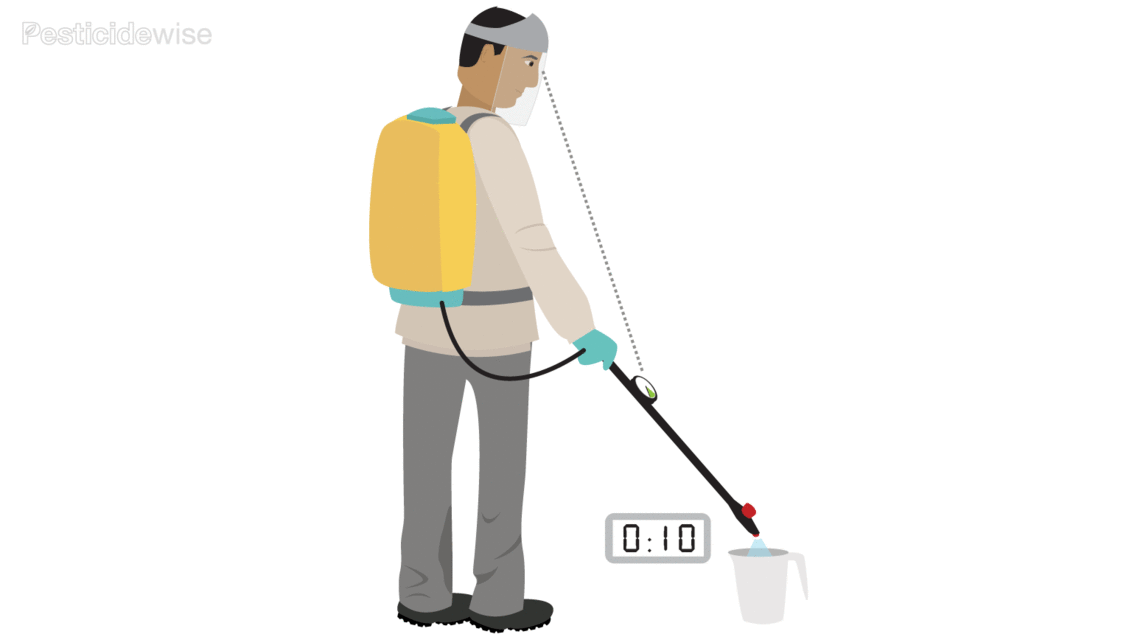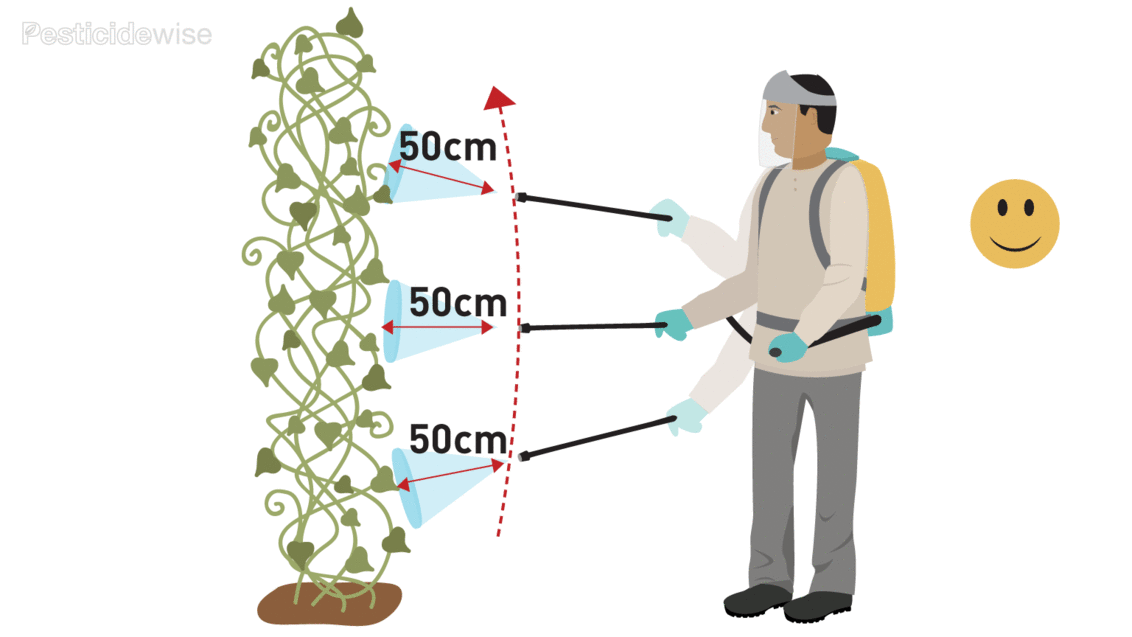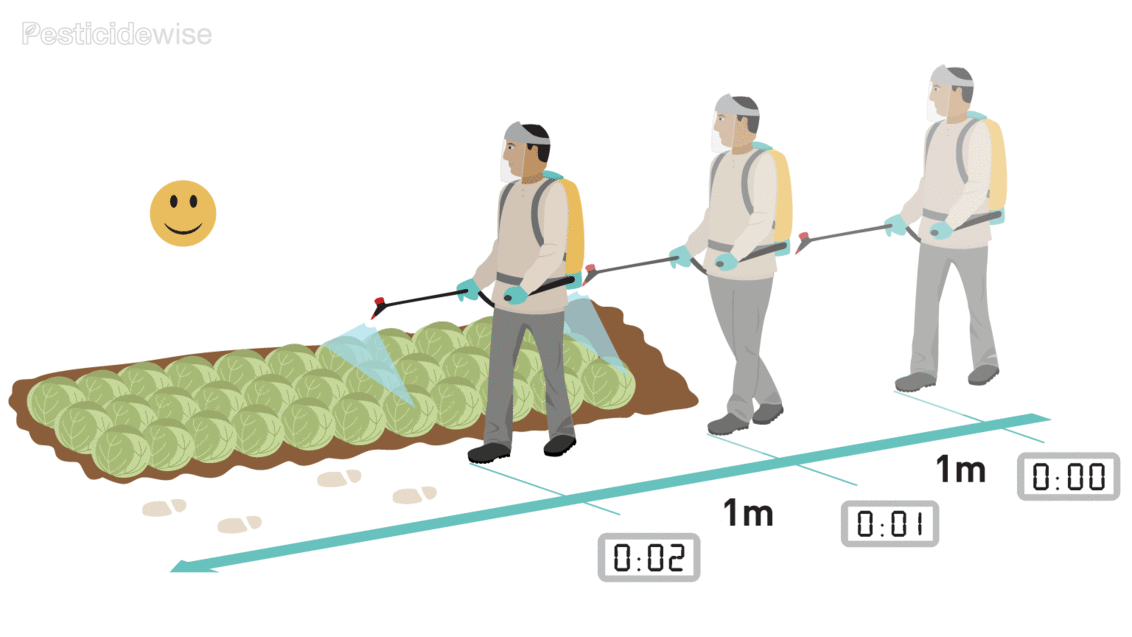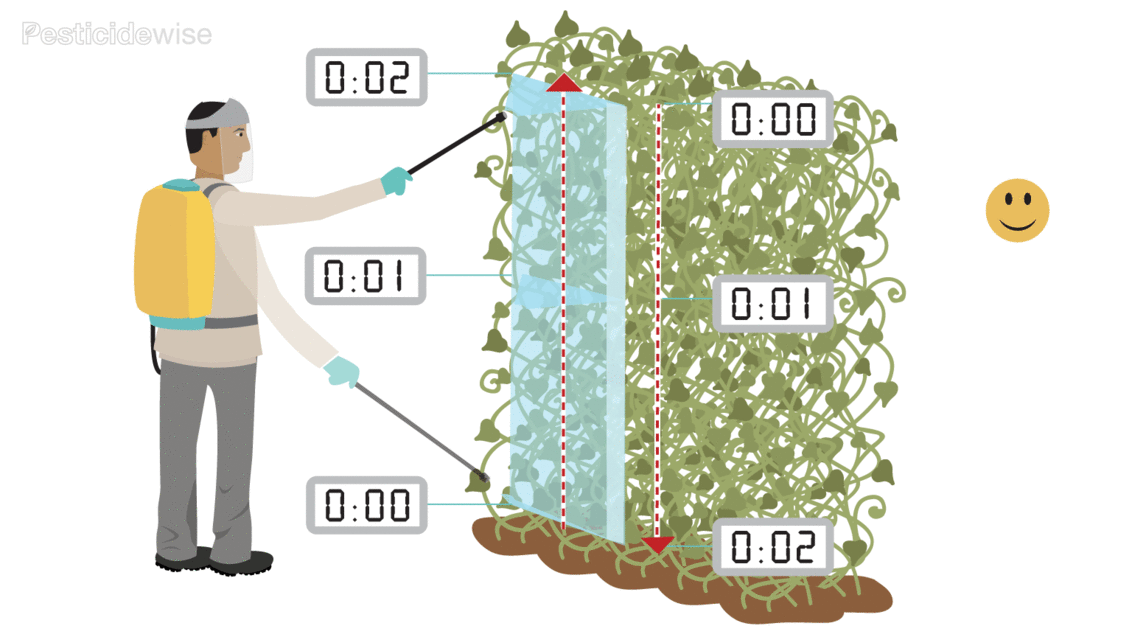1. A pesticide dose rate for a measured area e.g 2 L/ha: spray mix/water volume rate is known e.g. 200 L/ha
Example of pesticide dose
add
remove
A pesticide dose rate for a measured area is an amount of pesticide to be applied per square metre(s) or hectare of spray area. For example, "Apply 2 liters of product to the hectare (2 L/ha)". You will need to dilute your pesticide product in water to make the spray mix.
The Spray mix/water volume rate is a volume of spray mix to be sprayed over a measured area such as a hectare or number of metres. For example, "Apply at 300 L/ha".
Before you start
add
remove
To calibrate your sprayer for this spraying task you need to know:
- the size of your treatment area
- the type of nozzle and size of nozzle that you will be using.
When you found the size of nozzle that you need, you adjusted your sprayer so that you applied the right spray mix/water volume rate. Just before you spray is the right time to calibrate your knapsack sprayer more carefully and to practice again. Follow the steps below to make sure you are spraying the right amount of spray mix.
Check then fit your nozzle
add
remove

Check that your nozzle is in good condition. If your nozzle is damaged or worn then the spray pattern will be poor and you will either:
- spray too much pesticide which may damage your crop
- spray too little pesticide and fail to control the pest.
View the video resources to see how to fit a nozzle.
Practice keeping your knapsack sprayer at the right pressure
add
remove

Half fill your checked and clean knapsack sprayer with clean water. Lift the sprayer onto your back. Fasten and adjust the straps so that the knapsack sprayer is secure and stable, and that you feel comfortable
- Pump the lever steadily and carefully and increase the pumping rate until you get enough pressure to spray out some water.
- Raise the nozzle, and spray upwards for a few seconds until there is only water and no air in the supply pipes. Lower the nozzle to its spraying position.
- Find the best rhythm of pumping that holds the pressure that you need with the least effort and most comfort. When you have found the right pumping speed that maintains the pressure, count the rhythm. Is it one downward and one upward stroke every 5 seconds? Or slightly faster? Or slightly slower?
- Keep the pressure constant so that the amount of spray coming out of the nozzle is constant. This will help you apply the pesticide evenly.
- Practice until you are sure that you are able to maintain a constant pressure.
Pressure adjustors
Better knapsack sprayers are fitted with a pressure adjustor. These help you to maintain the best pressure for the type of nozzle, flow rate and drop size that you need.
Knapsack sprayers like this one have internal pressure regulators, which can be adjusted to spray at 1 bar (L) when using a deflector nozzle and 3 bars (H) when using a hollow cone nozzle.
Knapsack sprayers like this one can be adjusted to spray at 1, 2, 3 or 4 bar.
External pressure regulators can be fitted onto the lance as shown in this video, which shows you how to keep your knapsack sprayer at the right pressure.
Step 2 of 6 - calibrating your knapsack sprayer for pesticide dose and spray mix/water volume
Check your nozzle's actual flow rate
add
remove

You found your actual flow rate when finding out which size nozzle to use. Check it again now.
- Spray water into a metric measuring jug for exactly one minute at the pressure just practiced. Note the number of liters per minute (L/minute).
- Compare this actual flow rate to your required (planned) flow rate. If your nozzle sprays:
- too little water then pump faster to raise the pressure a little
- too much water then pump slower to lower the pressure a little.
- If you are still not getting the right flow rate:
- `check that your pressure regulator is set to the right pressure
- check that the nozzle is not damaged or worn
- check that the nozzle size you are using will produce the flow rate you need
- use a pressure gauge to help you maintain the correct pressure.
- Practice until you get the right volume of water sprayed.
See how to check the nozzle's actual flow rate.
Step 3 of 6 - calibrating your knapsack sprayer for pesticide dose and spray mix/water volume
Practice spraying at the right nozzle distance to get the right swath width
add
remove

If your nozzle is too close to the target surface, the spray drops moving through the air will not have enough time to spread out. This means that you will not spray the swath width or drop cover that you need. If the nozzle is too far away then you risk spray drops being blown away. Spray drift is a risk to:
- you
- other crops or livestock near-by
- bystanders
- your environment.
You will also risk the quality of your pest control because the spread of spray drops will be uneven. This wastes money.
So next:
- Find a dry surface that you can practice on. Position the nozzle at the right distance from your practice target surface (often 50 cm). If you are spraying downward, try using a weighted string tied to the lance to help maintain that distance whilst you practice.
- Spray water at the correct pressure until you can see the full spray width.
- Check that the spread of spray drops is right. If using an even flat fan, hollow cone or deflector nozzle, the spread of drops should be even across the whole spray width. If using a standard flat fan nozzle, there should be less spray at the margins of the spray width.
- Measure the swath width to make sure it is correct. (Remember if using a standard flat fan nozzle that the swath width will be less than the spray width. Learn more about the difference between spray width and swath width)
Review this video on how to measure a swath width.
Step 4 of 6 - calibrating your knapsack sprayer for pesticide dose and spray mix/water volume
Downward spraying: Practice maintaining your walking speed, nozzle distance and knapsack sprayer pressure
add
remove

Your spraying speed (ha/hour) is the speed at which the nozzle covers the target surface. Both your spraying speed and your walking speed (km/hour) are likely to change under different conditions. Check your walking speed each time that you spray. It is better to practice your walking speed in the area you will be spraying. If you practice on level, uncropped ground you may walk faster than when spraying in the treatment zone.
You will have found your walking speed for this spraying task, when finding out the size of nozzle that you need. To practice your walking speed and to complete the calibration:
- Place your knapsack sprayer on a flat piece of ground and half fill the tank.
- Spray again the test area that you set up when sizing your nozzle. Spray at the pressure, nozzle height and spraying speed, practiced.
- Check that the right amount of spray is being emitted.
Step 5 of 6 - calibrating your knapsack sprayer for pesticide dose and spray mix/water volume
View the video to see how this operator practices maintaining his spraying speed, nozzle height and spraying pressure. For the purpose of this demonstration we have calculated that to spray at a rate of 200 L/ha:
- The cone nozzle size we need has a flow rate of 600 ml/minute.
- The swath width produced by the nozzle is 0.75 metres.
- The knapsack pressure will be 3 bar.
- The operator will be spraying downwards with the nozzle 50 cms away from the foliage at a walking speed of 2.4 Km/hour.
Lateral/upward spraying: Practice maintaining your walking speed, nozzle distance and knapsack sprayer pressure
add
remove

Your spraying speed (ha/hour) is the speed at which you move the nozzle over the target surface. Both your spraying speed and your walking speed (km/hour) is likely to change under different conditions so check your walking speed each time that you spray. It is better to practice your walking speed in the area you will be spraying. If you practice on level, uncropped ground you are likely to be able to walk faster than when spraying in the treatment zone.
You will have found your walking speed when finding out the size of nozzle that you need. To practice your walking speed and complete the calibration:
- Place you knapsack sprayer on a flat piece of ground and half fill the tank.
- Spray again the test area that you set up when sizing your nozzle. Spray at the pressure, nozzle distance and spraying speed, practiced.
- Check that the right amount of spray is being emitted.
Check that the right amount of spray is being emitted
add
remove
To double-check that you have sprayed the right water volume rate:
- Place the knapsack sprayer on the same piece of flat ground as when you half-filled it.
- Mark the new water level.
- Use a measuring jug and carefully add water to raise the level back up to the original mark.
- Note how much water you added back into the tank. This is the amount that you sprayed over your test area.
To calculate how much water you should spray over the test area:
Step 6 of 6 - calibrating your knapsack sprayer for pestivides dose and spray mix/water volume
This video shows you how.
Compare the amount that you should have sprayed to the amount that you have actually sprayed over your test area. Is it the same?
- If not, then double check your choices and calculations made during calibration. Make sure that you have the right sized nozzle and that you know and can maintain your spraying speed.
- If it is the same, then your knapsack sprayer is now properly calibrated: your nozzles (when used as used during calibration) will spray the water volume rate needed and as advised on the pesticide label.
Next, try the spray mix calculator to find how much:
- spray mix you will need to make
- how much pesticide and water you will need in each knapsack sprayer load.
Spray mix calculator inputs
add
remove
To use the spray mix calculator, you will need to know:
- your pesticide dose rate (ml/ha, L/ha, g/ha, kg/ha)
- the size of your spray area (m2 or ha)
- your spray mix/water volume rate (L)
- the usable tank size of your knapsack sprayer (L).
The results will show, for this spraying task:
- the amount of pesticide product (ml, L, g, kg)
- the amount of water (L)
- the number of full knapsack sprayer loads
- any part load
- the amount of water (L) to add to each part or full load
- the amount of pesticide (ml, L, g, kg) to add to each part or full load.
Spray mix calculators: Pesticide dose rate and spray mix/water volume rate
add
remove
No content on the Live site